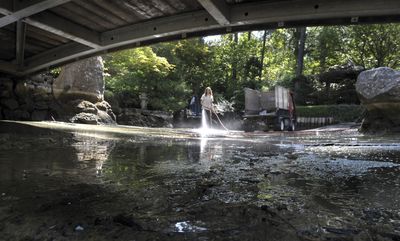Virus kills Japanese Garden koi
Introduction of foreign fish causes draining of Manito Park pond, destruction of survivors

The Japanese Garden pond at Manito Park is being drained and disinfected because of a viral outbreak that was killing the koi, some of which were as old as the garden itself.
The drastic – but unavoidable – action is the result of koi herpes virus, which causes the incurable and nearly always fatal KHV disease and was likely introduced by visitors releasing fish into the pond, said Steve Nittolo, horticulture supervisor for Spokane Parks and Recreation.
“We really want to get out the message for people not to put anything in the pond,” Nittolo said. “You’re not doing anyone, not even your goldfish, any favors.”
Goldfish, like some koi, are not susceptible to the disease, though they can be carriers of the virus. There are no health implications for humans.
Many of the pond’s 50 koi, a type of carp, died from KHV. Those removed from the pond on Tuesday may be carriers and will be destroyed, said Margie Luce, a member of the Inland Empire Water Garden and Koi Society, which has been assisting the parks department.
“Some well-meaning citizens probably don’t know to this day that they are the ones that caused this,” Luce said.
There is no way of estimating the value of the koi loss, she said. A koi can cost anywhere from $5 to “the sky’s the limit,” depending on size and coloration.
A koi can live 80 years or more, and some of those in the pond had been there since the Japanese Garden opened in 1974.
“The biggest ones were 25 inches,” Luce said.
Each year society members clean the pond and do a health check, at which time they typically notice and remove extraneous fish.
The latest check, on May 31, revealed two goldfish and one koi that did not belong.
Luce suspects the foreign koi of carrying the virus.
The koi began dying within a couple of weeks of the check, which is about the time the water would have warmed to above 64 degrees, the temperature at which the virus begins to kill.
So the infection could have been introduced from fall on, Luce surmised.
The veterinary department at Washington State University confirmed the presence of koi herpes virus from tests on five of the garden’s dead fish.
Luce believes it is Spokane’s first documented case of KHV disease.
The Inland Empire Water Garden and Koi Society has donated 30 new koi, but they will undergo four weeks’ quarantine at a water temperature of 75 degrees before they are introduced to the pond. Next year, 20 to 25 koi will be added to the pond.
In a notice released Tuesday, the Parks and Recreation Department advised members of the public to stop adding foreign fish to the Japanese Garden Pond.
“If they don’t, there will be no safe habitat for the koi and thus, no koi for the public to enjoy.”